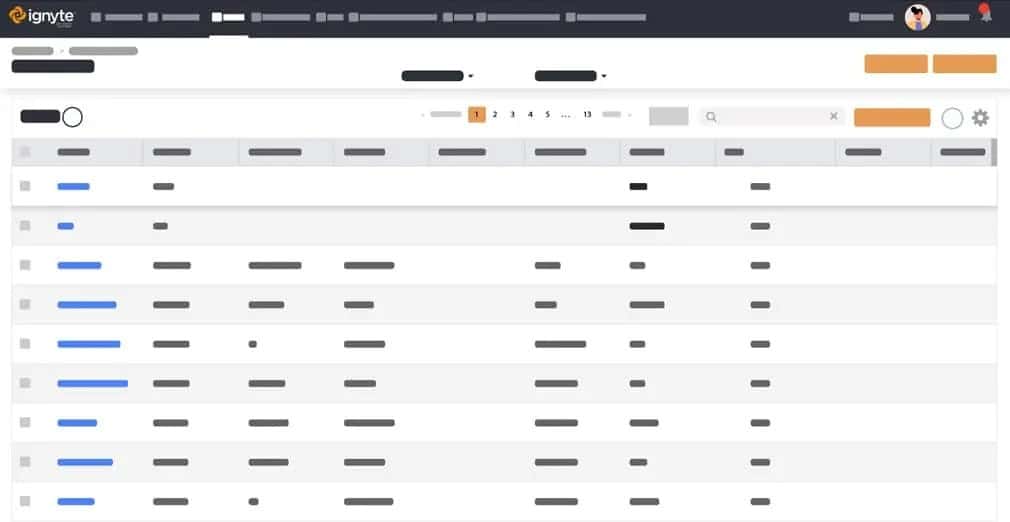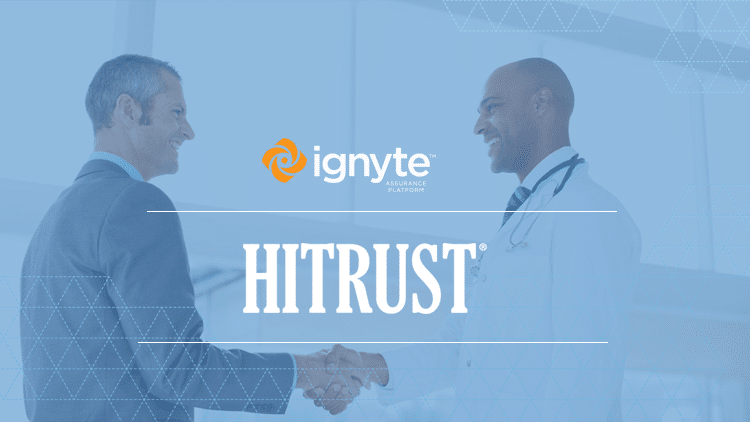 BLUF - Bottom Line Up Front
BLUF - Bottom Line Up Front
HITRUST certification is crucial for healthcare data security and regulatory compliance. It provides a structured framework to tackle cybersecurity threats and privacy issues. To achieve certification, organizations must implement specific controls, conduct self-assessments, and choose an experienced security provider like Ignyte Assurance. HITRUST helps manage risks, prevent data breaches, and enhances overall cybersecurity. A centralized compliance approach, such as using Ignyte Assurance Platform, is often more efficient than multiplatform solutions.
Secure storage and transmission of electronic data are increasingly vital to the healthcare industry, which faces unique challenges around sensitive data privacy and security. Meanwhile, the sector experiences challenge to safeguard sensitive data and remain compliant with regulations. Fortunately, HITRUST certification was developed to address many security, privacy, and regulatory challenges that face healthcare organizations.
This post addresses why HITRUST matters and how the dynamic security standard helps healthcare service providers protect against cyberattacks.
What is HITRUST?
HITRUST (Health Information Trust Alliance) certification is a standardized framework that assists covered entities to meet and demonstrate Health Insurance Portability and Accountability Act (HIPAA) compliance requirements. The standard prescribes various controls required to comply with multiple standards and regulations in the healthcare industry, including ISO/IEC 27000 series. Also, HITRUST is a cybersecurity framework designed for the healthcare industry to help organizations handling health data to achieve a specific cybersecurity state. Companies aspiring to meet HITRUST compliance requirements must develop a cybersecurity program demonstrating compliance before being certified.
HITRUST Certification Best Practices
The following are some of the best HITRUST practices enterprises should consider achieving for HITRUST certification:
- Implement required controls
There are mandatory cybersecurity controls an organization must implement before being certified as HITRUST compliant. While most companies rely on a cloud service provider’s implemented security configuration, internal cybersecurity teams are responsible for identifying and configuring missing controls. Fortunately, you can utilize the Ignyte Assurance Platform to map control requirements to existing safeguards to determine if any are missing. A glance at the centralized dashboard provides real-time information on whether your company is yet to meet all the required controls.
- Conduct a self-assessment
It is recommended for an organization first to perform an internal self-assessment when preparing for a HITRUST audit to streamline the assessment procedure. Conducting a self-assessment beforehand removes elements of surprises from the external audit team. An organization can reference various materials, including the HITRUST CSF, to identify compliance requirements checked during an assessment. An internal assessment’s primary goal should be to establish and validate how a company, vendors, and third parties can address safeguards and controls that form a cybersecurity framework.
- Gather self-assessment material for external auditors
Once the internal team completes a HITRUST self-assessment audit successfully, it must prepare for the actual evaluation. One way of simplifying an external HITRUST audit process is by gathering evidence and material to present to the external audit team. An organization must review the cybersecurity responsibilities as enforced by the internal security team, cloud providers, and other third parties. Also, maintaining an updated inventory of organizational cybersecurity controls can hasten and simplify the external audit process.
Choosing a HITRUST Security Provider for your Compliance Program
Cybersecurity providers and vendors play a vital role in helping organizations to jumpstart their HITRUST cybersecurity programs. When assessing possible security providers for your HITRUST compliance program, it is essential to consider the following factors:
- Does the provider offer specific cybersecurity control information?
- Does the security provider map organizational cybersecurity controls and services to both HITRUST and HIPAA regulations requirements?
- Does the provider offer continuous cybersecurity efforts and support?
Moreover, experience is the foremost attribute to consider when choosing a security provider to manage your HITRUST compliance program. Ignyte Assurance is one of the most reputable, knowledgeable, and experienced security providers that can flawlessly enable your organization to maintain a healthy HITRUST compliance certification. During a recent interview, William Scandrett, Allina Health CISO, praises Ignyte Assurance for its expertise in helping the health facility achieve and monitor its HITRUST compliance status. Alluding to the Ignyte Assurance Platform, Scandrett states that “It gave us a method to quickly produce reports with an assurance that we are monitoring things as close to real-time as we can without having to ask anybody for evidence.”
Experience aside, it is crucial to seek a security provider with an established time-to-market speed without compromising the certification process. Many providers lure unsuspecting clients with vague promises, such as low prices and rapid certification process. It is best if you are wary of security companies offering cheap and quick services and instead focus on organizations with an unrefuted ability to provide fast but proven services. Take Ignyte Assurance Platform, for example. Ignyte Assurance’s automation enables clients to manage compliance requirements quickly, efficiently, and at affordable costs from a capabilities perspective. The platform tracks risk metrics and customized workflows, eliminating manual compliance management, which can be costly and time-consuming. Scandrett echoes these advantages by urging potential clients that “if you’re looking to roll out a solution to give you what you want now without having to staff an entire function to run that tool, I think this is where the solution fits in well. I think the speed to market is pretty quick.”
How Hospitals can Cut Costs on HITRUST Compliance Maintenance
The biggest challenge in complying with any certification is the associated compliance costs. When complying with HITRUST, organizations may incur higher costs due to the connected compliance regulations, such as PCI DSS, NIST, COBIT, HIPAA, and HITECH. Fortunately, the Ignyte Assurance Platform can help hospitals and organizations in the healthcare sector cut costs significantly. The platform is fully automated to enable organizations to perform a self-assessment and determine missing HITRUST-required controls at a fraction of the cost it would take to perform the same exercise manually. Tim Rounds, Manager, Information Services – Governance, Risk and Compliance at Allina Health, noted the same benefit with satisfaction. While responding in an interview, Rounds stated that “We’re able to move off a bigger industry-recognized tool that required endless expenses for configuration changes during the first 1.5 years to get it running correctly, and use platforms like Ignyte to get everything done at a fraction of the previous budget and almost immediate roll-out plan.” It is a clear indication that the Ignyte Assurance Platform is not only a highly effective tool for managing compliance, but it is also the best cost-effective platform on the market.
Enhancing Cybersecurity and Risk Management in Healthcare
Why is HITRUST important?
HITRUST is essential because it demonstrates an organization’s capability in managing cybersecurity and the risks associated with health information and assets. The certification matters since it facilitates an entity’s ability to manage security risks, minimize data breaches targeting the healthcare industry, and demonstrate to external parties it takes compliance seriously. Also, relevant authorities update the HITRUST regulation regularly, which is vital to allow organizations to leverage the framework’s requirements to prepare for new cybersecurity risks.
It is also worth noting that the HITRUST CSF program is a practical risk management framework for organizations in the healthcare industry. The framework offers companies more profound insight into the third-party and internal risks, facilitating robust mitigation measures. As such, HITRUST encourages companies to continually improve their cybersecurity and risk management processes, enhancing the overall cybersecurity posture.
HITRUST assists organizations in enhancing their cybersecurity and risk management efforts in multiple ways. For instance, HITRUST CSF contains a scorecard through which companies can establish their cybersecurity protection levels and determine whether it conforms to the different requirements described by various regulatory bodies. HITRUST comprises different control categories, and the scorecard rates each type based on the organization’s cybersecurity scope. The ratings are crucial to ensuring that you meet the required controls and standards in the given industry.
Preventing Cybersecurity Weaknesses and Breaches in Healthcare
Complying with the HITRUST certification is an effective and proven method for preventing cybersecurity weaknesses and breaches in the healthcare sector. The regulation helps eliminate overlaps and inefficiencies created when attempting to comply with other regulatory standards mentioned above. Industry leaders and organizational CIOS can easily understand and follow the prescriptive security controls described in the HITRUST regulation enabling full compliance with critical cybersecurity requirements.
Furthermore, HITRUST describes a safe framework through which healthcare employees and organizations can share health data securely. The HITRUST’s comprehensive controls permit information security personnel to maintain secure, high-quality standards to enable the free flow of sensitive health information. Therefore, adherence to the set requirements can prevent cybersecurity breaches targeting confidential health data.
Once an organization has fully complied with the 19 controls identified in the framework, it can prevent data breaches and eliminate cybersecurity weaknesses that can jeopardize protected assets and data security. The controls range from data protection and privacy to endpoint security to ascertain that the entire IT infrastructure and data assets remain secure.
Multiplatform Solutions vs. Centralized
Now that we understand the essence of implementing a HITRUST compliance program and the resulting cybersecurity and risk management benefits, it boils down to one question: multiplatform or centralized? Which is the best one for your organization?
It is essential to note that both approaches have the same goal of ensuring you comply with the HITRUST regulation. However, a multiplatform solution has several disadvantages over a centralized method. It means dealing with a multi-tier process, where you must complete a series of tiring phases before you become compliant. Also, it is a challenge to track the missing controls in each platform since multiplatform solutions identify missing controls separately. On the other hand, a centralized method, such as the Ignyte Assurance Platform, offers all the services through a single dashboard. It is easy to monitor your compliance status and perform a self-assessment before beginning the actual audit process. [/et_pb_text][/et_pb_column]
[/et_pb_row]
[/et_pb_section]


